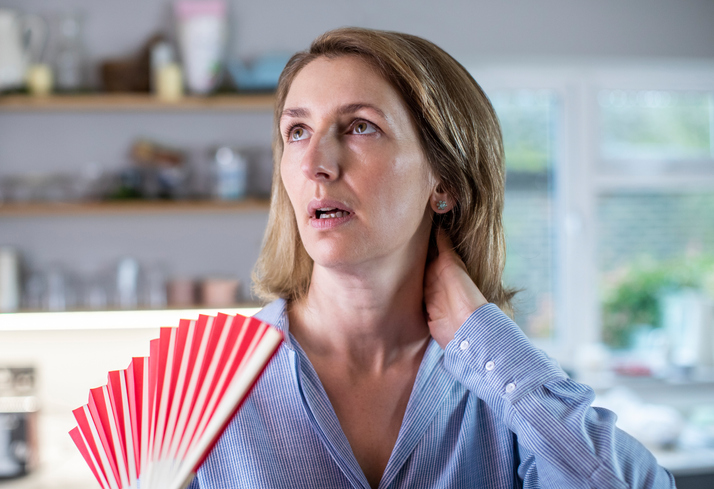Some Extra Help For Hot Flushes
Need some extra help to get control of your symptoms? Try these simple tips.

Every woman seems to respond differently and to have her own unique timetable for how they both respond to and suffer from hot flushes but there are some key measures that can give you the best chance of success.
Good hormone balance is essential and for this it is bioidentical natural progesterone that forms the base of any regime where oestrogen dominance is at work.
It is at perimenopause that this deficiency in progesterone is first seen as menopausal symptoms arising from oestrogen dominance occur and increase at menopause proper.
It is essential to have oestrogen adequately balanced by progesterone as this vitally important hormone increases sex drive, boosts adrenal production, helps and lessens fatigue, aids with thyroid dysfunction, helps with ‘fuzzy’ thinking and in balancing blood sugar.
Women with extreme symptoms can find they do need some oestrogen as well. If progesterone alone is not fully controlling their symptoms. they will be better helped by a combination cream of bioidentical natural progesterone and natural oestrogen.
So what else can help? There are a number of natural remedies, and therapies that you may want to try.
Flaxseed oil can help with night sweats, anxiety and moods and has a very high content of omega-3 fatty acids.
Evening primrose oil is rich in gamma-linolenic acid (GLA), a fatty acid involved in the production of hormone-like substances called prostaglandins.
Although not universally agreed on, as some studies have found it ineffective, women have found relief from hot flushes, night sweats, difficulty sleeping and migraines.
Zinc is a precursor for progesterone, so helps with hormone balance and protects the immune system. It is also a hormone balancer for excess oestrogen, and it helps to maintain a strong immune system.
Magnesium is helpful for those menopausal mood swings that can accompany hot flushes. If you keep waking at night take a supplement of around 400mg immediately before you go to bed.
Make sure you balance the magnesium with calcium as they work best together.
Herbs have been used for centuries and many women find them helpful, but if symptoms are severe. you may need some additional hormones as well.
Look for a combination like Wellsprings Menopause Capsules and look for some of the following: Black Cohosh, Red Clover. Dong Quai, Ginseng, Damiana, Chasteberry and Ashwagandha.
Natural phytoestrogens can help balance fluctuating hormone levels so add rich sources like yams, fennel, apples, nuts and flaxseeds for more help to balance your system.
Stress definitely makes hot flushes – and most other hormonal symptoms -worse. Find ways to reduce it in your life and take up a calming antidote such as yoga, meditation or tai chi.
Supplementing with the ‘stress vitamins’ C and B complex will also make a difference.
Lifestyle factors are important too so if you smoke, quit, as that is a major cause of hot flushes. Nicotine tells your body to release the chemical acetylcholine, which turns on the sweat glands. It also raises your heart rate, blood pressure, and body temperature.
Your diet affects flushes as eating processed food tends to heighten your blood pressure, so you may see an increase in your symptoms. Except for fatty fish and nuts, try to keep your intake of fat-laden foods to a minimum.
Eating healthily has many health benefits, but specifically for hot flushes a few small diet changes that might help are to increase.your intake of soy from sources such as edamame, tofu or tempeh.
Sugar is also best kept to a minimum as research has also linked high blood sugars to more hot flushes. One study which followed 3,000 women in their 40’s and 50’s over an 8-year period, found that women with higher blood sugar levels and insulin resistance had more frequent hot flushes.
Coffee triggers perspiration in two ways.First, caffeine activates the central nervous system, turning on sweat glands (the more caffeine you drink, the more you sweat). Second, the heat from the drink itself can make your body feel hot enough to sweat.
Spicy foods fool your body into thinking it’s hot by setting off the same nerve receptors that respond to heat. That’s why eating chilli or even a bowl of spicy soup can make your face bead up with sweat.
Alcohol can make your face flushed and sweaty. It is is due to an effect called vasodilation — widening of the blood vessels in the skin.
Exercise could make a substantial difference, as increasing your level of activity — everything from simple changes, such as taking the stairs instead of the elevator, or starting a formal exercise program — can reduce hot flushes and have a positive impact on just about every other symptom attributed to menopause.
Helpful information:
I hope some of these ideas have been helpful, and if you want to know why you get flushes, then read on!
https://anna.blog.wellsprings-health.com/why-women-get-hot-flushes-at-menopause/


















